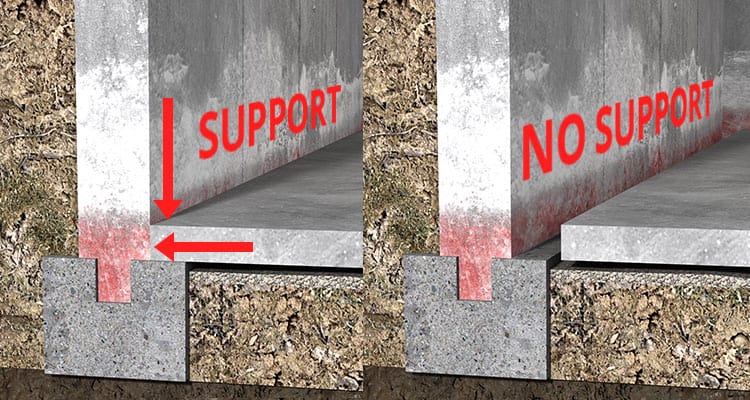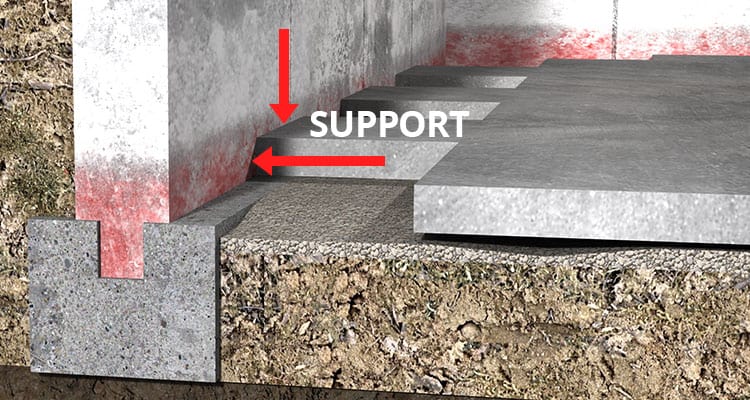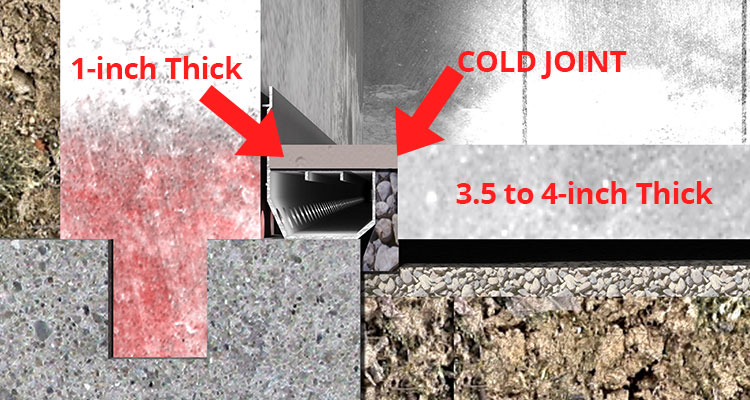Signs its Time to Replace Your Concrete Basement Floor
Here are a list of signs that show you it’s the time for you to replace your concrete basement floor:
- Cracks and Damage: One of the most obvious signs that it’s time to replace your concrete basement floor is the presence of cracks and damage. Over time, concrete floors can develop cracks due to various factors such as shifting soil, water damage, or heavy loads. If you notice multiple cracks or significant damage on your basement floor, it may be a sign that the concrete is deteriorating and needs to be replaced.
- Uneven Surface: Another sign that your concrete basement floor may need replacement is if it has become uneven or sunken in certain areas. Uneven surfaces can pose a safety hazard and may indicate underlying issues with the foundation. If you notice that your basement floor is no longer level or has significant dips and bumps, it’s time to consider replacing it.
- Water Leaks and Moisture Issues: A concrete basement floor should be able to withstand moisture and prevent water from seeping into your basement. However, if you start noticing water leaks, dampness, or mold growth on your basement floor, it may be a sign that the concrete is no longer functioning properly. In such cases, replacing the concrete floor is necessary to prevent further water damage and potential health issues related to mold.
- Persistent Odors: If you notice persistent musty or damp odors in your basement, it could indicate that moisture is seeping through your concrete floor. This could be a result of cracks or damage in the concrete, allowing moisture to accumulate and create a breeding ground for mold and mildew. Replacing the concrete basement floor can help eliminate these odors and improve air quality.
- Outdated or Unappealing Appearance: Sometimes, the decision to replace your concrete basement floor may not be solely driven by functional issues but also by aesthetics. An outdated or unappealing concrete floor can make your basement feel unwelcoming and visually unattractive. If you’re looking to update the look of your basement or increase its value, replacing the concrete floor can be a worthwhile investment.

Steps to Remove and Replace a Concrete Basement Floor
Prepare the workspace
Before starting the process of removing and replacing a concrete basement floor, it is important to prepare the workspace. This involves clearing out any furniture, belongings, or debris that may be present in the basement. It is also essential to ensure proper ventilation by opening windows or using fans to prevent the accumulation of dust and fumes.
Assess and mark the area
Carefully assess the area of the basement floor that needs to be removed and replaced. Use a tape measure and marking tools to clearly define the boundaries of the section that requires attention. This will help guide the removal and replacement process and ensure accuracy.
Remove the existing concrete floor
To remove the existing concrete basement floor, start by breaking it up into manageable sections using a jackhammer or a sledgehammer. Begin at one corner and work your way across the marked area, breaking up the concrete into smaller pieces. Use caution and wear protective gear such as gloves, safety glasses, and a dust mask to prevent injuries and minimize exposure to dust.
Clear debris and prepare the foundation
Once the concrete floor has been completely removed, clear the debris from the basement. Use a shovel and a wheelbarrow to remove the broken pieces of concrete and dispose of them properly. Next, prepare the foundation by ensuring it is smooth and free of any loose debris or dirt. It may be necessary to level the surface using a concrete grinder or by adding a layer of gravel or sand.
Install a vapor barrier
To prevent moisture from seeping through the new concrete basement floor, it is important to install a vapor barrier. This can be a sheet of polyethylene or a specialized moisture barrier designed for concrete floors. Lay the vapor barrier over the prepared foundation, ensuring it covers the entire area that will be replaced.
Pour and level the new concrete
Once the vapor barrier is in place, it is time to pour the new concrete basement floor. Prepare the concrete mixture according to the manufacturer’s instructions, ensuring it has the appropriate consistency. Pour the mixture onto the vapor barrier, starting at one corner and working your way across the marked area. Use a concrete float or a trowel to spread the concrete evenly and level it to the desired thickness.
Choosing the Right Materials for Your New Concrete Basement Floor
When it comes to replacing your concrete basement floor, choosing the right materials is essential for ensuring durability and longevity. There are various factors to consider before making a decision, such as the level of traffic, moisture levels, and personal preferences. Here are some key points to keep in mind when selecting materials for your new concrete basement floor:
Concrete Mix: Opting for a high-quality concrete mix is crucial for a strong and resilient basement floor. Consider using a mix that is specifically designed for basement applications, as it will have additives to enhance durability and resistance to moisture. Additionally, choose a mix with a higher compressive strength to withstand heavy loads and prevent cracking.
Vapor Barrier: Basements are prone to moisture issues, making a vapor barrier an essential component of your new concrete floor. A vapor barrier prevents moisture from seeping through the concrete and causing damage over time. There are various types of vapor barriers available, such as polyethylene sheets or epoxy coatings, so choose one that is suitable for your specific moisture levels.
Reinforcement: Reinforcing your concrete basement floor with steel or fiberglass mesh is advisable to enhance its strength and durability. These reinforcements help prevent cracking and shifting, especially in areas with heavy traffic or potential structural stress. The type and amount of reinforcement required will depend on the size and load-bearing requirements of your basement.
Surface Finishes: The choice of surface finish for your basement floor depends on both functional and aesthetic preferences. Consider options such as epoxy coatings, acid stains, or decorative overlays. Epoxy coatings provide a durable and moisture-resistant surface, while acid stains offer a unique and appealing appearance. Decorative overlays can mimic the look of various materials like stone or wood, adding a touch of elegance to your basement.
Sealants: Applying a sealant to your new concrete basement floor is essential for protecting it from moisture, stains, and wear. Sealants act as a barrier against spills, chemicals, and other potential sources of damage. Choose a sealant that is specifically designed for concrete floors and is compatible with the surface finish you have chosen.
Hiring a Professional Contractor for Your Concrete Basement Floor Replacement
When it comes to replacing the concrete floor in your basement, hiring a professional contractor is essential. This is a complex and labor-intensive project that requires expertise and specialized equipment. Here are some reasons why you should consider hiring a professional contractor for your concrete basement floor replacement.
Experience and Expertise: Professional contractors have years of experience in handling various concrete projects, including basement floor replacements. They understand the intricacies involved in the process and can ensure that the job is done correctly. Their expertise allows them to identify potential issues and provide effective solutions.
Quality Workmanship: A professional contractor will ensure that the replacement concrete floor is installed with the highest level of quality workmanship. They have the necessary skills to properly prepare the surface, mix and pour the concrete, and finish it to achieve a smooth and durable result. This will ensure the longevity and functionality of your new basement floor.
Time and Cost Efficiency: Hiring a professional contractor can save you both time and money in the long run. They have the knowledge and resources to complete the project efficiently and within the agreed-upon timeframe. Additionally, they can help you avoid costly mistakes that could arise from DIY attempts or hiring an inexperienced contractor.
Compliance with Building Codes: A professional contractor is well-versed in local building codes and regulations. They will ensure that the concrete basement floor replacement meets all the necessary requirements and passes inspections. This will give you peace of mind, knowing that your project is compliant with safety standards.
Insurance and Warranty: Reputable professional contractors carry insurance coverage, protecting you from any liability in case of accidents or damages during the project. Additionally, they provide warranties for their work, giving you assurance that any issues that may arise after the completion of the project will be addressed promptly and at no additional cost.
Ready For Concrete Flooring In Your Basement?
What’s in store when you replace your basement floor?
Starting On The Ground Floor With Basement Repair
Basement concrete floor repairs
Basement Floor Removal Part 2 Two Flat: Remade
Starting On The Ground Floor With Basement Repair – Textured Terrain
Attica Center – Progress on the Basement Floor
ASK THE INSPECTOR: Donu0027t get cracking just yet to replace floor
Foundation Replacement Boothbay Register
Starting On The Ground Floor With Basement Repair – Textured Terrain
Related Posts:











